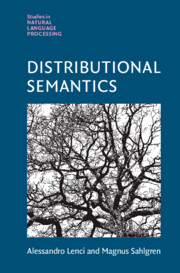6 - Neural Network Models
from Part II - Models
Published online by Cambridge University Press: 07 September 2023
Summary
The most recent development in distributional semantics is represented by models based on artificial neural networks. In this chapter, we focus on the use of neural networks to build static embeddings. Like random encoding models, neural networks incrementally learn embeddings by reducing the high dimensionality of distributional data without building an explicit co-occurrence matrix. Differing from the first generation of distributional semantic models (DSMs), also termed count models, the distributional representations produced by neural DSMs are the by-product of training the network to predict neighboring words, hence the name of predict models. Since semantically similar words tend to co-occur with similar contexts, the network learns to encode similar lexemes with similar distributional vectors. After introducing the basic concepts of neural computation, we illustrate neural language models and their use to learn distributional representations. Then we pass to describe the most popular static neural DSMs, CBOW, and Skip-Gram. We conclude the chapter with a comparison between count and predict models.
- Type
- Chapter
- Information
- Distributional Semantics , pp. 143 - 168Publisher: Cambridge University PressPrint publication year: 2023

